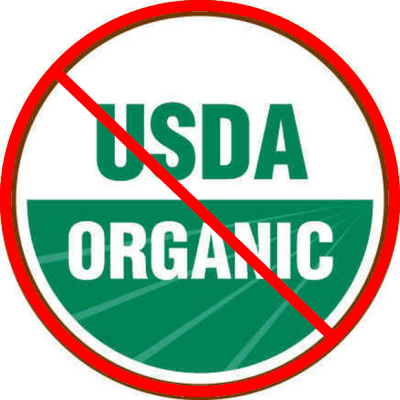 Why would the average consumer decide to switch to organic food? Typical reasons include food of higher quality that is hopefully more nutritious although conventional produce grown locally and picked at the peak of ripeness would no doubt rival the nutrition of organic produce picked early and shipped long distances. Consumers also generally assume that any food labeled as USDA Organic will not contain any dangerous ingredients or chemicals like carrageenan.
Why would the average consumer decide to switch to organic food? Typical reasons include food of higher quality that is hopefully more nutritious although conventional produce grown locally and picked at the peak of ripeness would no doubt rival the nutrition of organic produce picked early and shipped long distances. Consumers also generally assume that any food labeled as USDA Organic will not contain any dangerous ingredients or chemicals like carrageenan.
After all, buying certified organic food is still the only way to avoid genetically modified ingredients as GMOs are regularly slipped into healthfoods labeled as “natural” and even those containing organic ingredients but less than 70% organic overall.
Based on these assumptions, consumers would likely be surprised and even shocked to learn that a likely human carcinogen that triggers massive gastointestinal inflammation and symptoms in many people continues to be allowed by the National Organics Standards Board (NOSB) for inclusion on the list of ingredients permitted in certified organic food – food bearing the USDA Organic label!
This dangerous ingredient, carrageenan, which most consumers are unaware is lurking in so many of their beloved organic products, seems harmless enough at first glance.
Derived from seaweed, carrageenan is a highly processed food additive that has no nutritional function whatsoever.
What it does do is act as a fat replacer or stabilizer in certain types of dairy products, commercial dairy substitutes like soy milk, coconut milk, hemp seed milk, almond milk, and other processed foods.
As you can see, buying lowfat is not a good idea and not just for the fact that you are losing the valuable whole fats that satiate and steady the blood sugar. By opting for lowfat or alternative dairy products, consumers are choosing instead to consume a toxic additive that is a likely carcinogen!
Carrageenan a Potential Carcinogen
Even Dr. Andrew Weil has been telling people about carrageenan dangers since 2002.
Carrageenan is so toxic and inflaming to the human digestive system that this food additive is formally classified by the International Agency for Research on Cancer (part of the World Health Organization) as a potential human carcinogen.
Scientists first discovered that carrageenan causes gut inflammation as far back as the 1960’s. Inflammation is a very serious condition as it is a primary symptom in IBS, Crohn’s Disease, ulcerative colitis, and colon cancer as well as dozens of other diseases.
The hype from the carrageenan industry claims that “food grade” carrageenan is different from the low molecular weight, i.e., degraded carrageenan that is toxic to human cells.
This spin fails to mention that not a single sample of products containing carrageenan that were tested could be said to be free of the degraded form. Some samples contained as much as 25% low molecular weight carrageenan. This testing was conducted as part of a 2003 ruling by the European Commission’s Scientific Committee on Food which required that a maximum of 5% degraded carrageenan be contained in a processed food which includes the additive.
Another problem is that research available since the early 1980’s indicated that even food grade carrageenan is probably converted during the digestive process to the degraded, highly toxic form. More recent research sponsored by the National Institutes of Health (NIH), pinpointed the exact metabolic process by which carrageenan triggers inflammation. Shockingly, this biological event was found to mirror the way pathogenic bacteria such as salmonella wreak havoc in the gut.
The takeaway for consumers from this very discouraging NOSB ruling is to not take anything for granted just because a product is labeled USDA Organic. It still could be extremely damaging to your health!
Avoiding lowfat dairy and processed dairy substitutes is a very wise course of action. If you have a dairy allergy, learn to easily make healthy milk substitutes at home that are free of carrageenan dangers!
Be aware that most commercial pet food is loaded with carrageenan too. Check the labels to be sure your furry friends don’t suffer from its unhealthy effects as well.
Sarah, The Healthy Home Economist
Sources and More Information
The Cultivator, News from the Cornucopia Institute, Summer 2012








Thank you so much for this post. Even this former Home Ec Teacher did not know about the toxicity of this ingredient. I am a 14+ year Stage 4A Lymphoma survivor, and am careful about my diet, and now I will screen this out as well. Blessings!
Thank you for raising the alarm about this horrible garbage, Sarah. It is so important for people to know this.
Shame on the organic board for allowing this to be used in organic foods. Come to think of it, it should not be use din any food.
Mr. Fishman — Thanks so much for the info on Red Boat Fish Sauce! I love fish sauce — it has a million uses — but, as you point out, it’s darn near impossible to find one made the traditional way. I’ll pick up some Red Boat this weekend.
We love Red Boat fish sauce, too, Linda! It’s delicious!!
Darnit! Another thing to avoid. What could they have used instead? Chia seeds are such a great binder, too bad they can’t grind those up and use them somehow. It would be much healthier, I love Chia!
We were living in WI and had wonderful raw dairy always on hand. We recently moved to Alaska and have no access to raw milk of any sort. I have found eggs from locals but that is it. Our children always had real issues with pasteurized dairy to the point that we didn’t eat dairy at all until we were in WI with the raw milk available. It was truly amazing; the difference in the kids (all of us) enjoying milk with nothing but pure benefits and no horrible rashes, etc.
Since moving to AK, I have been purchasing almond milk and Organic Valley whole (ultra-pasteurized) milk and use it sparingly. I don’t know what to use anymore. I hate that the whole milk is pasteurized (“ultra” at that) and see no benefit to it. Our youngest can’t drink it at all and he loved the raw milk in WI. I’m upset that this junk is found in almond and coconut milk. We have no access to coconuts and almonds will cost a small fortune to ship here but I’m willing to do it if necessary. I’ve never made almond or coconut milk before so I’m not sure where to start with that; will have to look online.
What to you suggest is best if raw milk isn’t an option at all and the stuff on the store shelf isn’t up to par? Are store-bought almond and coconut milk beneficial anyway? They seem too thick to be ‘real’ in the first place.
More of a sidenote question… We do have access to KerryGold butter and can order grass-fed ghee online. Is one better than the other? (I was making our own raw milk butter…. *sigh*)
Thanks so much for all the articles and information you share with us. It’s greatly appreciated!
I would suggest finding pasteurized cream (not ultrapasteurized) and diluting with some filtered water. You can also make the coconut milk tonic if you click on the second link in the post above. Canned whole coconut milk with no additives can be found fairly easily.
Good luck! I did notice on my trip to Alaska this summer how expensive everything is at the grocery store. My heart goes out to you. Do the best you can and I’m sure you will find a way.
Heather, I don’t know what part of Alaska you are living in, but there are sources of raw milk available. Since it is illegal to sell raw milk here there are places that have cow shares and also those that sell for animal use only. At this time of year the milk is dwindling, but keep checking around. The Mat-Su valleys have quite a few farmers and also down on the Kenai Peninsula. There are homesteaders all over really, but I don’t know about Southeast. I belong to a food co-op that orders from Azure Standard. (Our freight costs about .50-.60 per pound.) You can contact them to find any co-ops in your area. People who order from them may have more sources local to you where you can find some of theses things. A few years ago I spoke with someone at Matanuska Creamery and she told me they feed their cows on pasture and then grain in the winter. It is just regular pasteurized. It’s not the best, but certainly better than the Organic Valley ultrapasturized junk. (The only time I ever got sick on dairy was from some of their half&half). They were selling the cream only at their store in Wasilla by the gallon. I also believe the milk was being sold in the Fred Meyer stores in Anchorage. I haven’t checked in quite a while. (I am hardly ever in that area). There are also many people who raise goats. You might be able to find goat milk somewhere. Check the Real Milk website too. I don’t think the co-operative extension service could help you since it is illegal, but they might direct you to some 4-Hers or to some feed stores that might have some information. Check the bulletin boards up at stores. I hope this is helpful to you.
Where did you find Kerry Gold butter??!!!
@Jennifer I understand you not wanting difficult posts but they are necessary … I mix it up with positive posts, recipes videos, tips etc but sometimes we have to get into the nitty gritty. There is a war for our health going on after all. We must stay informed.
@Jennifer I have not used it but Annette at Wilderness is VERY picky about the products they carry .. I trust her instincts and am sure that product is excellent.
The coconut milk powder has maltodextrin in it. Isn’t that a sugar?? It also has sodium caseinate added (to keep the oil in the follicle). Not sure what that is but if its from dairy then I can’t have it! I was about to purchase this from my health food store until I saw those to ingredients.
Thank you for this reminder. I was just looking at coconut milk today and it was in there, I didn’t buy it.
You can make coconut milk at home very easily with some coconut manna from nutiva and water. 🙂 Best if you have a vitamix or blendtec blender though. You can also just used dried coconut and water. Same can be done for nut milks at home. 😉
There are a number of Applegate meats that use carageenan in their products. Here’s a post I wrote about their meats and how they are not nitrate-free as the packaging would have you believe (another lie):
http://agriculturesociety.com/healthy-living/deceptions-in-the-food-industry-applegate-organic-natural-meats/
Thanks for sharing this, Raine. We have to look for this toxic glop in just about everything!
Yes, boo-hiss on Applegate. Their label says Applegate Naturals, Changing the Meat We Eat. I guess in this case, changing it by adding a carcinogen. Let’s write to Applegate and ask them to stop this harmful practice.
Sarah – Have you used coconut milk powder like what is sold Wilderness Family Natural to make your tonic? I am having.to choose what I have time to make and thought skipping the whole coconut piece would be a time saver for me.
@ Jennifer: I looked up the coconut milk powder at Wilderness Family Naturals: They list 95% dried coconut milk, 2% sodium caseinate and 3% maltodextrin. On another of Sarah’s posts:
https://www.thehealthyhomeeconomist.com/chicken-broth-no-msg-labels-are-false/
The commenter “Nevra” says that in the book Excitotoxins, sodium caseinate is listed as another name/form for MSG. I think Sarah has also villified maltodextrin, but I don’t recall for sure. Maybe you could write WFN and ask them about this and post their response here, such as what is the source of sodium caseinate and is it just a form of MSG?
pd